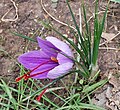User:Jaoconnell/sandbox
| Saffron crocus | |
|---|---|

| |
| C. sativus blossom with crimson stigmas | |
| Scientific classification | |
| Kingdom: | |
| (unranked): | |
| (unranked): | |
| Order: | |
| Family: | |
| Subfamily: | |
| Genus: | |
| Species: | C. sativus
|
| Binomial name | |
| Crocus sativus | |
| Synonyms[1] | |
| |
Crocus sativus, commonly known as saffron crocus, or autumn crocus,[2] is a species of flowering plant of the Crocus genus in the Iridaceae family. It is best known for producing the spice saffron from the filaments that grow inside the flower.
The cormous autumn-flowering perennial plant species is unknown in the wild.[2] Human cultivation of saffron crocus and use of saffron is known to have taken place for more than 3,500 years and spans different cultures, continents, and civilizations, see history of saffron. Crocus sativus is currently known to grow in the Mediterranean, East Asia, and Irano-Turanian Region[3].
Description
[edit]Crocus sativus has a corm which holds leaves, bracts, bracteole, and the flowering stalk.[3] These are protected by the corm underground. On the flower, there are purple petals as well as small yellow stamen and three long red stigmata. C. sativus generally blooms with purple flowers in the autumn. The plant grows about 10 to 30 cm high.[4] C. sativus is a triploid which means it has three times the haploid number of chromosomes. This makes the plant sterile due to its inability to pair chromosomes during meiosis. C. sativus in particular has 24 chromosomes.[5]
Cultivation
[edit]Crocus sativus is unknown in the wild, and its ancestor is unknown. The species Crocus carthwrightianus is the most probable ancestor,[6] but C. thomassi and C. pallasii are still being considered as potential predecesors.[7] Manual vegetative multiplication is necessary to produce offspring for this species as the plant itself is a triploid that is self-incompatible and male sterile, therefore rendering it incapable of sexual reproduction. This inability to reproduce on its own supports the hypothesis that C. sativus is a mutant descending from C. carthwrightianus as a result of selective breeding.
Corms of Crocus sativus should be planted 4 inches apart and in a trough 4 inches deep. The flower grows best in areas of full sun in well-drained soil with moderate levels of organic content[8]. The corms will multiply after each year, and will last 3-5 years[9].
Use
[edit]Saffron is considered to be the most valuable spice by weight.[3] See spice. Depending on the size of harvested stigmas, 50,000 - 75,000 Crocus sativus plants are needed to produce about 1 pound of saffron [10]; each flower only produces three stigmas. Stigmas should be harvested mid-morning when the flowers are fully opened[9].
Gallery
[edit]-
Illustration from Köhler's Medizinal-Pflanzen (1897)
-
Flower's profile, Serra de Casteltallat, Catalonia, Spain
See also
[edit]References
[edit]- ^ "The Plant List: A Working List of All Plant Species". Retrieved 23 April 2015.
- ^ a b USDA GRIN Taxonomy, retrieved 23 April 2015
- ^ a b c Kafi, M. "Saffron (Crocus Sativus): Production and Processing". Science Publishers, 2006.
- ^ Mollazadeh, Hamid "Razi’s Al-Hawi and saffron (Crocus sativus): a review". Iranian Journal of Basic Medical Sciences, Dec 2015.
- ^ Saxena, R. "Botany, taxonomy and cytology of Crocus sativus series".AYU (An International Quarterly Journal of Research in Ayurveda), vol. 31, no. 3, 2010, p. 374.
- ^ Rubio-Moraga, A; Castillo-Lopez, R; Gomez-Gomez, L; Ahrazem, O (23 September 2009). "Saffron is a Monomorphic Species as Revealed by RAPD, ISSR and Microsatellite Analyses". BMC Research Notes. 2 (189). doi:10.1186/1756-0500-2-189. PMID 19772674.
{{cite journal}}: CS1 maint: unflagged free DOI (link) - ^ Caiola, M. G. (2003). "Saffron Reproductive Biology". Acta Horticulturae. ISHS (650): 25-37.
- ^ "Growing and Harvesting Saffron Crocus". White Flower Farm.
- ^ a b "Saffron Farming Information Guide". AgriFarming.
- ^ Hill, T (2004). The Contemporary Encyclopedia of Herbs and Spices: Seasonings for the Global Kitchen (1st ed.). Wiley. p. 273. ISBN 978-0-471-21423-6.
External links
[edit]![]() Media related to Crocus sativus at Wikimedia Commons
Media related to Crocus sativus at Wikimedia Commons




